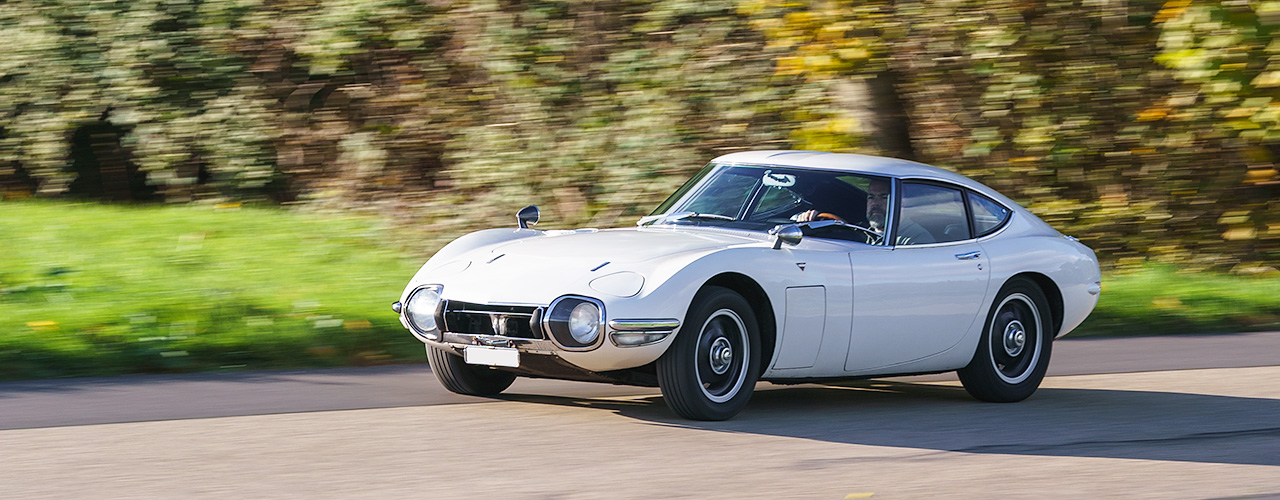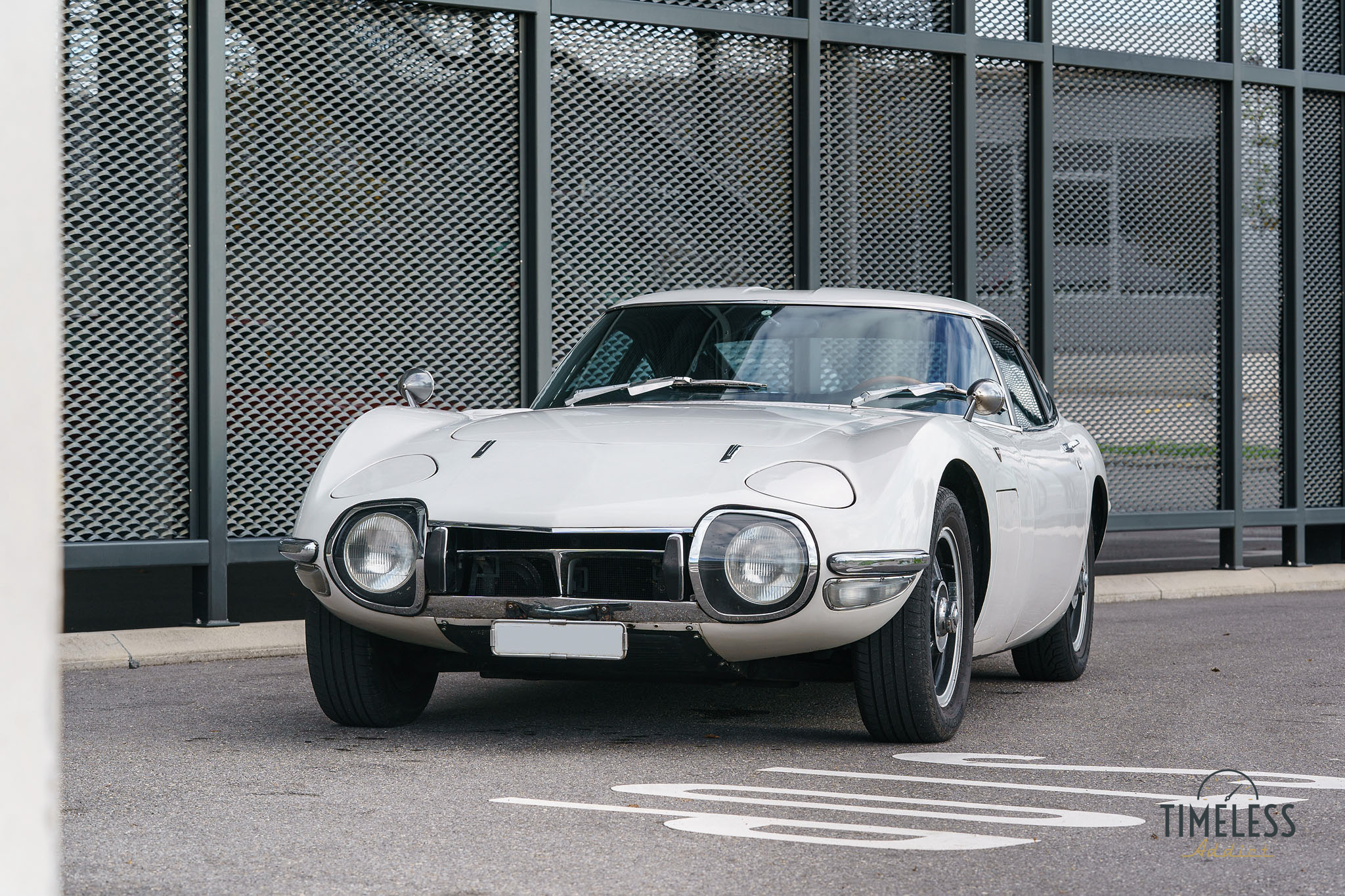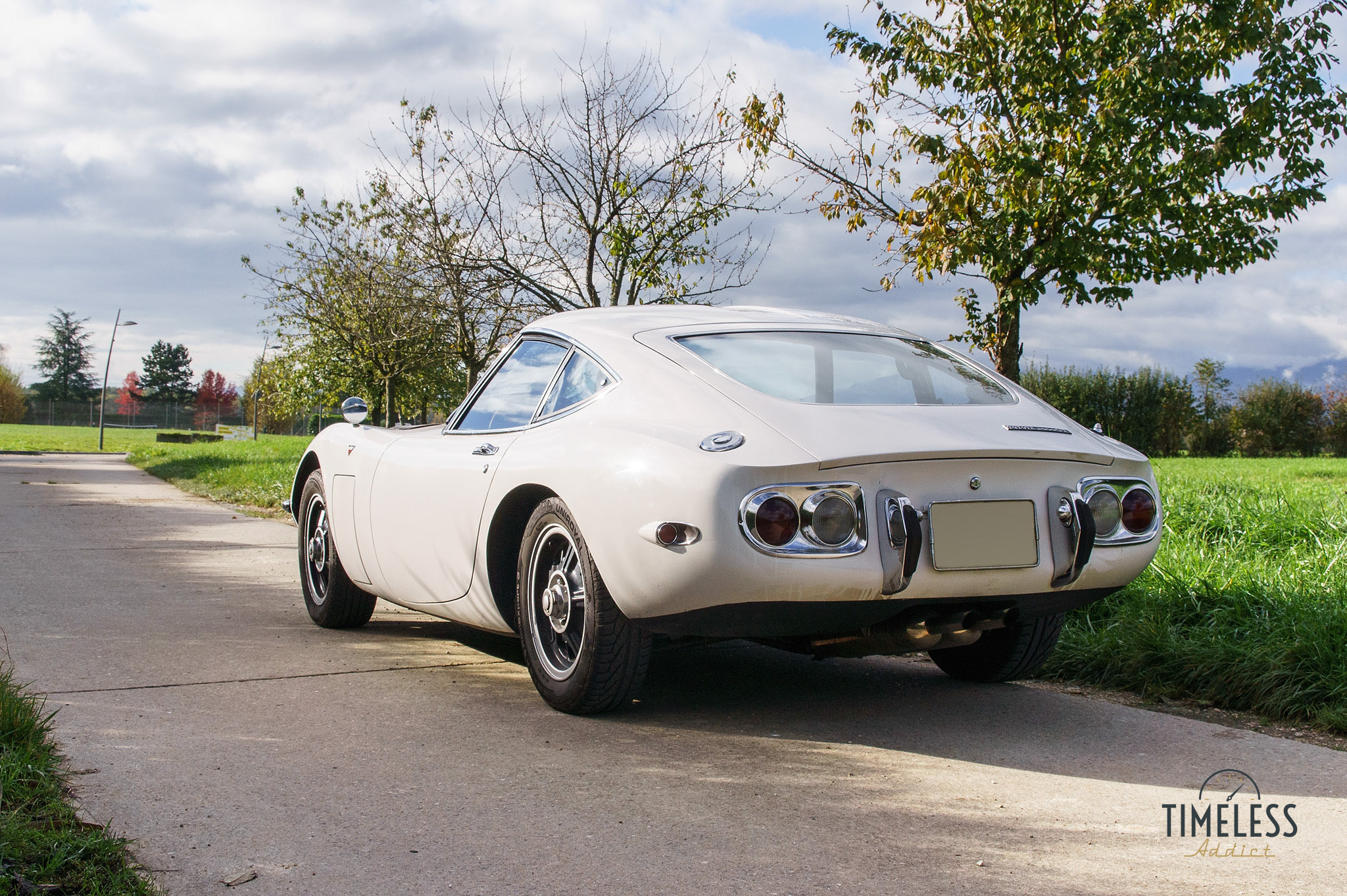
Text: Sebastien Morand
Photos : Claude-Alain Ferrière, Sebastien Morand
Unknown to many because of its rarity, the Toyota 2000 GT is probably one of the most beautiful Japanese cars ever designed. Launched at the end of the 1960s, it hoped to shake things up but without any real success.
Today, it has become a myth and it is therefore with great pleasure that Timeless Addict is able to offer you this test drive.
In the 1960s, when people talked about GT Coupes, two cars immediately came to mind: the Jaguar E-Type and the Porsche 911. It was to go and overshadow them that Toyota's management decided to design the 2000 GT. However, with a higher price tag and a badge with no real prestigious reputation, the expected result did not happen. Between 1967 and 1970, only 351 cars were produced, of which less than 100 were left-hand drive.
To give you a better idea of its exclusivity, only three cars were imported into Switzerland at that time. Today, only one of these three is still in our country, the one we are testing today. A second one is known in our country, it can be seen at Emil Frey Classic in Safenwil and it comes from Belgium. It is therefore a great privilege for Timeless Addict to be able to make this report.
At first glance, without knowing or recognising it, many people think that the beautiful Japanese car actually comes from England. Elegant yet sporty lines, it is very similar to the E-Type. However, while the width is almost identical, the Toyota is almost 30 cm shorter (4'175mm versus 4'458mm) and 6 cm lower (1'160mm versus 1'220mm). This may not seem like a big deal on paper, but when you see it in real life, it's quite obvious.
Moreover, when you see the car, you notice that the design of the 2000 GT is a bit more curved, with the best example being the windscreen, which is much more inclined and very rounded. Without denying the Jaguar's sublime appearance, I have to admit that the Toyota's design looks more dynamic. It's really a great achievement by the Japanese designer Satoru Nozaki.
At the front, it's hard not to notice the big round headlights hidden behind their plexiglass window. But you'll probably be surprised to learn that these are only fog lamps and that they are also used for headlights. Indeed, the high beam lights are retractable, also circular and of significant size.
There are no badges on the bonnet, just inscriptions on the sides and rear. On the other hand, the inside of the grille has a T-shaped structure, like the first letter of Toyota. Only a very observant eye will notice this.
The long bonnet is grafted with the shell-shaped rear-view mirrors, which is very nice and totally in the spirit of the time, especially on Japanese cars. However, in terms of efficiency, it's not really optimal. Another particularly well worked detail is the door handles which I find sublime and as it's not easy to describe them, I invite you to look at the pictures.
After the long, receding roofline, the rear of the 2000 GT is truncated, like on the Alfa Romeo Giulia TZ. But remember, this is not the only one, as I also mentioned this feature in our test of the Aston Martin DB6. Another car with similar styling is the Ferrari 365 GTB/4 Daytona, but the size is much larger.
Coming back to our 2000 GT, I particularly like the round rear lights, placed on a fully chromed element, and the ribbed roof in the spirit of Zagato's work. The magnesium wheels and the central double exhaust tailpipe are also very similar to the E-Type.

Before moving on to the interior, let's have a look at the mechanics of this Toyota 2000 GT as some body elements are directly linked to it.
You probably didn't notice them because the general line of the car is so impressive but on each side, between the front wheel and the door, there is a cut-out in the wing. These are not aesthetically interesting, they are hatches to simplify access to various elements such as the air filter, the battery, the windscreen washer tank and other mechanical parts. To open these panels, you first have to open the engine cover and then remove the small ventilation grilles on either side of it. This design shows how Toyota engineers have gone to great lengths to optimise the car's design while integrating it into the car's lines.
Now that the heart of the car is accessible, we discover an inline 6-cylinder borrowed from the Crown S, the Toyota sedan of the time. However, to install it in the 2000 GT, it underwent a vitamin treatment orchestrated by Yamaha. Three Mikuni carburettors, a new aluminium cylinder head and double overhead camshafts (the first time on a Japanese car in series production), all the know-how of the Japanese manufacturer specialised in motorbikes, especially in competition, is present.
The result is a 2.0 6-cylinder engine (1,998 cm3 to be precise), code-named 3M, which develops 150 bhp at 6,600 rpm for a torque of 177 Nm at 5,000 rpm. To deliver the power to the rear wheels, the engine is coupled to a 5-speed manual transmission. An automatic transmission was available as an option, but only a very small number of customers opted for it. In terms of performance, the 0-100 km/h time is 9 seconds and the top speed is 220 km/h.
At the end of its career, in order to reduce manufacturing costs, the 2000 GT saw its engine evolve, well, regress in absolute terms. The block is now the 2M-B, the one of the Crown, with a displacement of 2'253 cm3, losing 10 hp but gaining 24 Nm. In the end, less than 10 examples were produced; the beautiful adventure came to an end because the sales never reached the expected results.

The design of the Toyota 2000 GT is based on a beam chassis, similar to the famous Lotus Elan. The Japanese engineers were directly inspired by the latter to design the 2000 GT's chassis. Like the British car, it has an X shape that surrounds the engine and the gearbox at the front, while at the rear we find the axle. The weight distribution is almost perfect with 51% at the front and 49% at the rear.
Another first for a Japanese production car, the 2000 GT has four disc brakes and four independent suspensions. With a weight of just over a ton, precisely 1,120 kg, the sensations are there, I'll come back to that in a moment.
The Toyota 2000 GT was entirely hand-assembled in Yamaha's factories, and in this respect, the same wood as used for the brand's musical instruments was used for the dashboard. Different wood species are used for each model, which explains the differences in appearance you can see from one 2000 GT to another.
This rather luxurious and cosy interior is slightly different from the very sporty exterior. This was probably the intention of the designer, Toshiro Okada, to distance himself from the austerity of the Porsche 911 and the classicism of the Jaguar E-Type. The mix of brown wood and black leatherette reinforces the elegance of our strict Japanese two-seater.
The instrumentation is complete, with a multitude of small meters in the centre of the dashboard and facing the driver. It's hard for me to say that it's more successful than in the Jaguar, as I love the British car so much. I think it's mainly a matter of taste but one can only admire the singularity of the final rendering in this Toyota 2000 GT.
The seats are slightly bucket, offering a good level of comfort and sufficient support. With a very low floor, you'll just have to get used to sliding into the car and not be taller than 5'8" if you don't want to be too cramped.
The interior of this 2000 GT is full of special features and I will only mention the most important ones. First of all, the headliner is particularly soft, it could be from Rolls-Royce as the padding is so thick. There is also an adjustable steering column, bluffing for the time, as well as a cruise control but the latter was not functional on the cars delivered in Europe.
Before sharing my impressions of the car, I will briefly introduce our test car. It left the factory in March 1968 and was registered in Switzerland on 15 November of the same year. The car is painted in one of the two white colours available in the catalogue, this one is called "Pegasus White".
As I said earlier, this is one of the three cars that were imported into our country and it is the only one that is still here. What is even more amazing is that it has been in the same family since the early 1970s. The current owner's father bought it second-hand from the Grand Garage des Nations, the Toyota dealer in Geneva, in the late 1960s. The three cars imported into Switzerland were ordered from the latter at that time.
To return to our car, its first owner, a certain Henri Nobs, had replaced the Mikuni carburettors with more efficient Webers which are still in the car today. Today, this 2000 GT is approaching 100,000 km and has never been restored. In its original state, it has a magnificent patina which, in my opinion, gives it a much more desirable charm than a car that has been rebuilt.
It's all very well to praise the Toyota 2000 GT by presenting its looks and its mechanics, but it's time to discover what it feels like when you're behind the wheel.
As usual, I start the test on the passenger seat. This allows me to see how the car behaves and to benefit from the owner's explanations. I am quickly impressed by the silence and comfort on board. We are in a real GT, ready to swallow the kilometres.
It's time to get behind the wheel and I immediately feel at ease. The driving position is excellent and the controls fall perfectly under the hand. From the very first kilometres, the good impressions felt as a passenger are confirmed, this Toyota is really pleasant to drive and is easy to handle.
The muffled sound of the 6-cylinder engine delicately enchanted my ears. I will notice later, when I watch the car leave at the end of the day, that from the outside, the music of the engine is much more pronounced. A guarantee of quality in terms of soundproofing for the occupants, while asserting its character for the people who cross the road of our Japanese.
Light and agile, driven by the 150 hp of its 6-cylinder engine, our 2000 GT quickly makes us feel that it is ready to apply a more sustained rhythm to our ride. So I increase the pace and discover the car's dynamic temperament. The engine is very supple, so the revs rise smoothly. But when we reach 4,000 rpm, the atmosphere becomes a little more dynamic and I'm encouraged to keep going. But my reasoning calms my ardour. I am not here to set a time, but to live an experience and share it with you.
And you don't need to go fast to realise how good the chassis is. The 2000 GT corners with great ease, it's really a pleasure to drive and quite amazing for the time. I'll have to try an E-Type soon to compare the behaviour.
With its sporty look, one expects a sharp engine and this is probably the most confusing aspect. This engine is very flexible, it allows you to easily get back into second gear and it runs perfectly. However, beware of speeding because with this rather muted atmosphere, you tend to drive faster than allowed.
In addition to this excellent chassis and this wonderful engine, I also noticed that the brakes were very efficient for the time.
Like the Honda NSX in the early 90's, this Toyota 2000 GT is a real success. Unfortunately, it failed to convince a clientele that was already influenced by the car's brand rather than by the sensations it provided.
For the record, 007 fans could also admire a convertible version of the 2000 GT in the movie "You Only Live Twice". Indeed, while our elegant 2000 GT was selected, the production realized that Sean Connery, 1m88, did not fit in the car. So Toyota had no choice but to design two convertible prototypes; but this model never made it to production.
The test drive of this Toyota 2000 GT is coming to an end. This is my chance to see it on the road. It's really sublime and it confirms my idea that this is one of the most beautiful Japanese cars ever produced.
Our thanks to Luc for making available his magnificent and rare Toyota 2000 GT as well as for the information he was able to gather on this exceptional Japanese car that I invite you to discover on his website.
Other articles
Jérôme Courville
Geneva Rhone 8,
Rue du Commerce 4,
1204 Geneva - Switzerland
(+41) 788 889 017
 English (United Kingdom)
English (United Kingdom)  Français (France)
Français (France) 